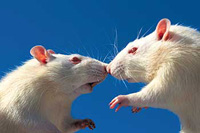Scientists learn to milk mice
A unique milk farm was created at the Institute of Gene Biology of the Russian Academy of Sciences. Instead of cows there live … mice.

“This is a stage of a global experiment conducted by the Unified State of Russia and Belarus ,” the supervisor of this project Igor Goldman says. “The goal is to create effective and biologically safe medicines of a new generation as well as sound baby food. The basis for such products is human protein. We are going to reproduce it from animal milk, for instance, of goats or mice.
The latter are the most suitable creatures to test the production of the expensive substance. By “order” of scientists they produce the protein of woman’s milk – lactoferrin. One such mouse costs $3,000.
“Our mice are transgenic. The first mouse of this kind was born here in 2001. We start to milk them when they deliver babies. The lactational period lasts 21 days. During this time we take milk two times only, for the babies must get their food too. One she-mouse gives a drop of milk at a time. A study has revealed that this milk is just like woman’s milk and even excels it in some aspects,” scientist Elena Sadchikova says.
How are mice milked? Some researchers cut mice’s nipples and squeeze the valuable liquid out, others use special crucifixion machines or put she-mice to sleep with ether.
“In our laboratories there is no cruelty,” researcher Tatyana Ermolkevich said. Previously she sucked milk out through a thin tube, but it was a very difficult and slow procedure. Seeking to mechanize the process they decided to adapt a peristaltic pump, which is used in medicine for blood transfer.
The living conditions for these valuable rodents are perfect. Mice live in absolutely clean cages. There is a plate on each cage with passport data of the inhabitants. A small group of mice lives in each cage. She-mice are isolated from babies two hours before milking. Then scientists induce anesthesia and inject a special relaxing medicine, so that she-mice do not resist being milked.
“Our scientists together with their colleagues from Belarus have learned to extract from 15 to 40 grams of human lactoferrin from one liter of transgenic mice’s milk,” senior scientist Aleksey Deykin says. “It is much more than a breastfeeding woman can give. There is no such an effective technology of producing this valuable protein anywhere else in the world. No more than half a gram is extracted from the same milk volume abroad. We received evidence that these methods can be applied in experiments with goats. As a result, two transgenic goats were born,” he said.
Scientists plan to create a flock of 500 transgenic goats. Human lactoferrin taken from them will be used for producing breast milk substitutes for newborn babies receiving no mother milk. The new substance will guard babies from bacterial, viral and fungal infections. As a result, child mortality can be considerably reduced. Moreover, the milk of transgenic animals will give an opportunity to make cheap and highly effective protein-based medications, which are very expensive now.
Express Gazeta
Subscribe to Pravda.Ru Telegram channel, Facebook, RSS!




